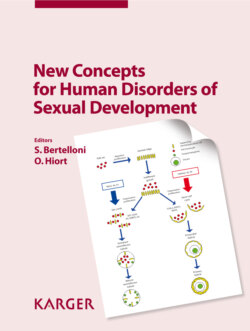Читать книгу New Concepts for Human Disorders of Sexual Development - Группа авторов - Страница 22
На сайте Литреса книга снята с продажи.
Introduction
ОглавлениеIn humans, the important first steps of sexual differentiation occur during the initial 7 weeks of embryonic development and appear as several successive events starting with establishment of the genetic sex, development of the gonadal ridge and immigration of primordial germ cells followed by a sexually dimorphic differentiation of the gonadal anlagen into either testes or ovaries. Until this point of time, referred to as the indifferent stage of gonadal development, no morphologically distinct sex differences can be noticed in developing human gonads. One critical event in sex differentiation is the determination of the gonads. This developmental phase establishes the hormonal dimorphism which, in turn, has a major impact on several later events of the male as well as female paths. This review will deal with differentiation of the male gonad covering its maturation from its first appearance to the pubertal activation. Recent discoveries added to increase the knowledge of testicular ontogenesis together with the growing list of genes involved in this process will be presented and discussed.
Table 1. Chronology of important early events in human male sex differentiation
| Event | Age at start (dpc) | Size CRL (mm) |
| Genetic sex | 0 | |
| PGC migration from yolk sac | 28 | 4 |
| Formation of gonadal ridge | 32 | 5 |
| PGCs reach gonadal ridge | 37 | 10 |
| Male sex determination | 42 | 15 |
| Leydig cells appear | 55 | 30 |
| Androgen, INSL3 detectable | 63 | 40 |
| Testicular descent (1st phase) | 64 | |
| dpc = Days post conception; CRL = crown rump length (‘sitting height’). |
